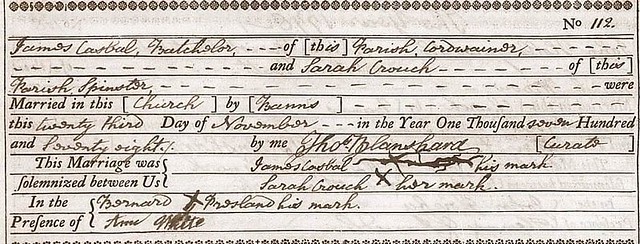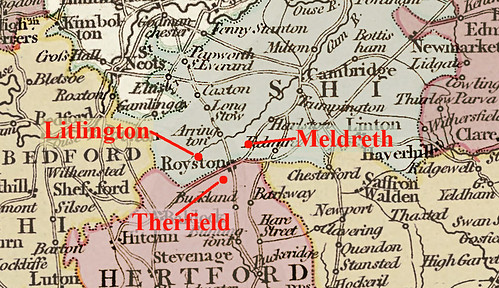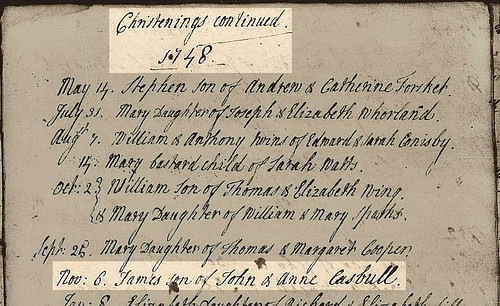Much of today’s post is based on supposition. I will try to distinguish between firm conclusions and those based on weaker evidence.
Our story begins with a marriage that took place 23 November 1778 in the village of Therfield, Hertfordshire. James Casbal, a cordwainer (shoemaker) and bachelor, married Sarah Crouch, a spinster (unmarried woman).[1]

Excerpt from Therfield parish records, showing marriage of James Casbal and Sarah Crouch,
23 November 1778 (Click on image to enlarge)
The marriage record tells us that both James and Sarah were from the parish of Therfield. We can also see that both signed with their mark, an indication of some degree of illiteracy. Therfield is a small village in Hertfordshire, located about 2 ½ miles southwest of Royston, and more importantly, about 6 miles from Meldreth, Cambridgeshire. Meldreth is the ancestral home of many of the today’s Casbons, Casbans and Casbens.

Detail of a map of England showing southern Cambridgeshire (green), northern Hertfordshire (red, bottom center), and adjacent counties; the relative locations of Meldreth, Therfield, and Litlington are indicated; adapted from John Cary, “A new map of England, from the latest authorities” (London: John Cary, 1809); downloaded from David Rumsey Map Collection (davidrumsey.com); Creative Commons License
The marriage of James and Sarah is the first instance where “Casbal” or related surnames appear in Therfield records, so we can make a safe assumption that James was not born there. Casb—l was an early variant of the Casbon surname and appears in various parish records during the late 1700s. Members of the Crouch family had been living in Therfield for several generations.
James and Sarah had a daughter, Ann, who was baptized at Therfield 24 January 1780.[2] However, the birth apparently caused Sarah’s death, since her burial was recorded on
21 January.[3]
James was soon remarried, this time to Martha Crouch, on 13 August 1780.[4] Sarah and Martha were probably cousins. James and Martha had a daughter, Lydia, who was buried on 24 October 1782, just 10 days after her baptism.[5]
Lydia’s burial marks the last record of this family in Therfield. This suggests that the family might have moved to a different location.
I believe that location was Litlingon, Cambridgeshire. Litlington is another small village, located about 3 ½ miles north of Therfield and 4 ½ miles from Meldreth (see map, above). Litlington parish records reveal that James Causbell, a shoemaker, was buried there on 31 August 1804.[6]

Burial record of James Causbell; detail from Litlington parish registers, 1804 (Click on image to enlarge)
Although I can’t be certain, the fact that he was a shoemaker provides circumstantial evidence that James of Litlington was the same man who was married at Therfield in 1778. There just weren’t that many men with that surname or its variants and I have been able to account for most of the others.
Where did James come from? I believe he was the son of John (about 1721–1796) and Ann (Chamberlain) Casborn of Meldreth. We have met John before. Born in Orwell, he served his apprenticeship in Meldreth and presumably stayed there for the rest of his life. He was also appointed as the parish clerk in his later years. John is one of the earliest identified ancestors of many of today’s living Casbons (also Casbans and Casbens). John and Ann had two sons named James; the first died in infancy. The second was baptized at Meldreth
6 November 1848.[7]

Detail from Meldreth parish registers showing the baptism of James Casbull in 1848 (Click on image to enlarge)
It is notable that John Casborn was also a cordwainer. This is part of the reason I believe James of Therfield to be his son. The other reason is that I can find no other records—no burial or marriage record—of James in Meldreth. My theory is that James learned the shoemaking trade from his father and then moved to Therfield, where he was married and started a family. He moved to nearby Litlington some time before his death in 1804. Unfortunately, his age is not given in the burial record, so this cannot be used as another point of comparison.
There is one other piece of evidence that supports the theory. It is the record of baptism for James Causbell at Litlington 29 March 1819.[8]

Detail from Bishop’s Transcripts, Litlingon Parish, Cambridgeshire, 1819, showing
the baptism of James Causbell 29 March 1819 (Click on image to enlarge)
The record tells us that James was the “baseborn [illegitimate] son” of Ann Causbell. The father’s name is not given, but other records suggest that his name was Thomas Taylor, a labourer. Remember that James of Therfield had a daughter named Ann from his first marriage. The fact that the child’s name was James is also significant. Traditionally a first son would be named after the father’s father and the second son would be named after the mother’s father. But this was not a hard and fast rule, and in the case of illegitimacy, using the mother’s father’s name would be understandable.
Unfortunately, I haven’t been able to find any other records relating to Ann or her son James, so their story ends in 1819. Nor have I been able to find any other records of James’s (of Therfield) second wife, Martha.
It’s a circumstantial case, but I think it’s reasonable to believe that the men named James Casbal/Causbell of Therfield and Litlington, and the child baptized as James Casbull at Meldreth in 1748 are the same person. If so, he would have been the brother of Thomas Casbon (about 1743–1799), my fifth great-grandfather.
[1] Hertfordshire, Therfield Parish, Register of Marriages, 1778, p. 27, no. 112; imaged as “Hertfordshire Banns & Marriages,” Findmypast (https://search.findmypast.com/search-world-Records/hertfordshire-banns-and-marriages : accessed 15 Feb 2017).
[2] “England Births and Christenings, 1538-1975,” FamilySearch (https://www.familysearch.org/search/collection/1473014 : accessed 19 Mar 2020).
[3] Hertfordshire, Therfield Parish, general register, “Burials 1780”; imaged as “Hertfordshire Burials,” Findmypast (https://search.findmypast.com/search-world-Records/hertfordshire-burials : accessed 15 Feb 2017).
[4] “England Marriages, 1538-1973,” FamilySearch (https://www.familysearch.org/search/collection/1473015 : accessed 19 Mar 2020).
[5] Hertfordshire, Therfield Parish, general register, “Burials 1782”; imaged as “Hertfordshire Burials,” Findmypast (https://search.findmypast.com/search-world-Records/hertfordshire-burials : accessed 15 Feb 2017).
[6] Cambridgeshire, Litlington, Bishop’s Transcripts, 1804; browsable images, “Bishop’s transcripts for Litlington, 1599-1864,” FamilySearch (catalog) (https://www.familysearch.org/search/film/007561135?cat=976865 : accessed 19 Mar 2020) >DGS Film no. 007561135 >image 186 of 460.
[7] Parish of Meldreth (Cambridgeshire, England), General Register Volume P118/1/1 [1682–1782], n.p. (baptisms 1746-50), James Casbull, 6 Nov 1748; accessed as “Parish registers for Meldreth, 1681-1877,” browsable images, FamilySearch (https://www.familysearch.org/search/film/007567609?cat=210742 : accessed 29 August 2017) >DGS film no. 007567609 >image 110 of 699.
[8] Cambridgeshire, Litlington, Bishop’s Transcripts, baptisms, 1819; browsable images, “Bishop’s transcripts for Litlington, 1599-1864,” FamilySearch (catalog) (https://www.familysearch.org/search/film/007561135?cat=976865 : accessed 19 Mar 2020) >DGS Film no. 007561135 >image 231 of 460.








